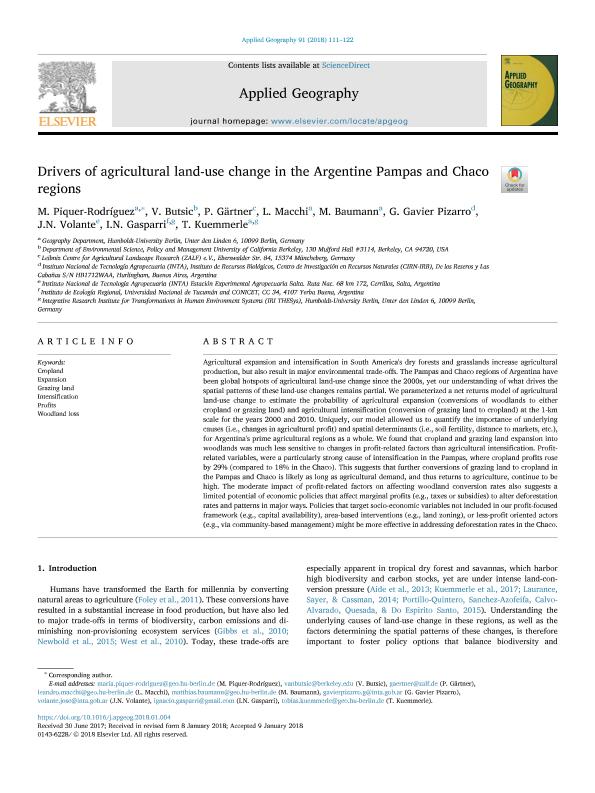Artículo
Drivers of agricultural land-use change in the Argentine Pampas and Chaco regions
Piquer Rodríguez, María; Butsic, Van; Gärtner, P.; Macchi, Leandro ; Baumann, Matthias; Gavier Pizarro, Gregorio
; Baumann, Matthias; Gavier Pizarro, Gregorio ; Volante, José Norberto; Gasparri, Nestor Ignacio
; Volante, José Norberto; Gasparri, Nestor Ignacio ; Kuemmerle, Tobias
; Kuemmerle, Tobias
 ; Baumann, Matthias; Gavier Pizarro, Gregorio
; Baumann, Matthias; Gavier Pizarro, Gregorio ; Volante, José Norberto; Gasparri, Nestor Ignacio
; Volante, José Norberto; Gasparri, Nestor Ignacio ; Kuemmerle, Tobias
; Kuemmerle, Tobias
Fecha de publicación:
02/2018
Editorial:
Elsevier
Revista:
Applied Geography
ISSN:
0143-6228
Idioma:
Inglés
Tipo de recurso:
Artículo publicado
Clasificación temática:
Resumen
Agricultural expansion and intensification in South America's dry forests and grasslands increase agricultural production, but also result in major environmental trade-offs. The Pampas and Chaco regions of Argentina have been global hotspots of agricultural land-use change since the 2000s, yet our understanding of what drives the spatial patterns of these land-use changes remains partial. We parameterized a net returns model of agricultural land-use change to estimate the probability of agricultural expansion (conversions of woodlands to either cropland or grazing land) and agricultural intensification (conversion of grazing land to cropland) at the 1-km scale for the years 2000 and 2010. Uniquely, our model allowed us to quantify the importance of underlying causes (i.e., changes in agricultural profit) and spatial determinants (i.e., soil fertility, distance to markets, etc.), for Argentina's prime agricultural regions as a whole. We found that cropland and grazing land expansion into woodlands was much less sensitive to changes in profit-related factors than agricultural intensification. Profit-related variables, were a particularly strong cause of intensification in the Pampas, where cropland profits rose by 29% (compared to 18% in the Chaco). This suggests that further conversions of grazing land to cropland in the Pampas and Chaco is likely as long as agricultural demand, and thus returns to agriculture, continue to be high. The moderate impact of profit-related factors on affecting woodland conversion rates also suggests a limited potential of economic policies that affect marginal profits (e.g., taxes or subsidies) to alter deforestation rates and patterns in major ways. Policies that target socio-economic variables not included in our profit-focused framework (e.g., capital availability), area-based interventions (e.g., land zoning), or less-profit oriented actors (e.g., via community-based management) might be more effective in addressing deforestation rates in the Chaco.
Palabras clave:
CROPLAND
,
EXPANSION
,
GRAZING LAND
,
INTENSIFICATION
,
PROFITS
,
WOODLAND LOSS
Archivos asociados
Licencia
Identificadores
Colecciones
Articulos(IER)
Articulos de INSTITUTO DE ECOLOGIA REGIONAL
Articulos de INSTITUTO DE ECOLOGIA REGIONAL
Citación
Piquer Rodríguez, María; Butsic, Van; Gärtner, P.; Macchi, Leandro; Baumann, Matthias; et al.; Drivers of agricultural land-use change in the Argentine Pampas and Chaco regions; Elsevier; Applied Geography; 91; 2-2018; 111-122
Compartir
Altmétricas



